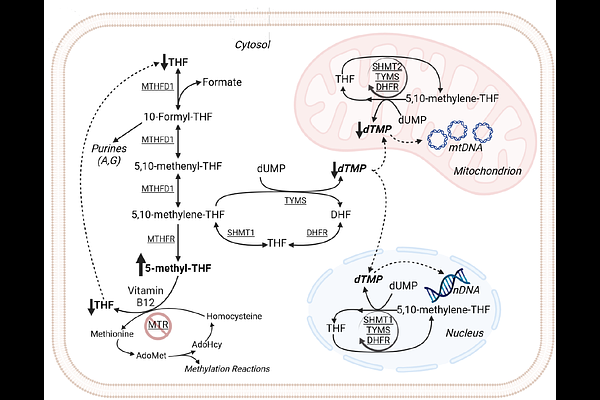Vitamin B12 supports skeletal muscle oxidative phosphorylation capacity in male mice

Vitamin B12 supports skeletal muscle oxidative phosphorylation capacity in male mice
Castillo, L. F.; Heyden, K. E.; Williamson, A. R.; Ma, W.; Malysheva, O. V.; Vacanti, N. M.; Thalacker-Mercer, A. E.; Field, M. S.
AbstractObjectives: Vitamin B12 plays a vital role in folate-mediated one-carbon metabolism (FOCM), a series of one-carbon transfer reactions that generate nucleotides (thymidylate (dTMP) and purines) and methionine. Inadequate levels of B12 impair FOCM, depressing de novo thymidylate (dTMP) synthesis, which in turn leads to uracil accumulation in DNA. This phenomenon has been well documented in nuclear DNA. Our previous work in liver tissue has shown that mitochondrial DNA (mtDNA) is more sensitive to FOCM impairments in that mtDNA exhibits elevated uracil levels before uracil concentrations in nuclear DNA change. However, the functional consequences of uracil accumulation in mtDNA are largely unknown. The purpose of this study was to determine how a functional B12 deficiency (induced by reduced levels of the B12-dependent enzyme methionine synthase (MTR)) and dietary B12 deficiency affects mtDNA integrity and mitochondrial function in energetic and mitochondria-rich tissues such as skeletal muscle. Methods: Male Mtr+/+ and Mtr+/- mice were weaned to either an AIN93G-based control (C) diet containing 25 /kg vitamin B12 or a B12-deficient (-B12) diet containing 0 /kg vitamin B12 to explore the effects of functional (Mtr+/-) and dietary B12 deficiency on muscle weight, uracil content in mtDNA, mtDNA content, and oxidative phosphorylation complex capacity in skeletal muscle. Aged (20-22mo) male C57BL6/N mice were acclimated to an AIN93G control diet four weeks, then received either weekly injections of saline (vehicle control [30 uL 0.9% NaCl]) or B12 (0.65mg per 30uL 0.9% NaCl) in each of two hindleg muscles [1.25 mg B12 total]) for 8 weeks. Results: The tibialis anterior (TA) muscle from Mtr+/- mice exhibited lowered maximal respiratory capacity of complex I, II, and IV of the electron transport chain than did TA from Mtr+/+ mice. Exposure to the -B12 diet lowered maximal capacity of complex I in red, mitochondrially rich muscle (soleus and mitochondria-rich portions of quadriceps and gastrocnemius) (p=0.02). Levels of uracil accumulation in mtDNA in red muscle and gastrocnemius were elevated ~10 fold with exposure to -B12 diet (p=0.04 and p<0.001, respectively). In aged mice gastrocnemius complex IV activity increased with intramuscular B12 supplementation (p=0.04). Conclusions: Exposure to a B12-deficient diet led to uracil accumulation in mtDNA and impaired maximal oxidative capacity in two different types of skeletal muscle. B12 supplementation improved complex IV maximal capacity in gastrocnemius from aged mice.